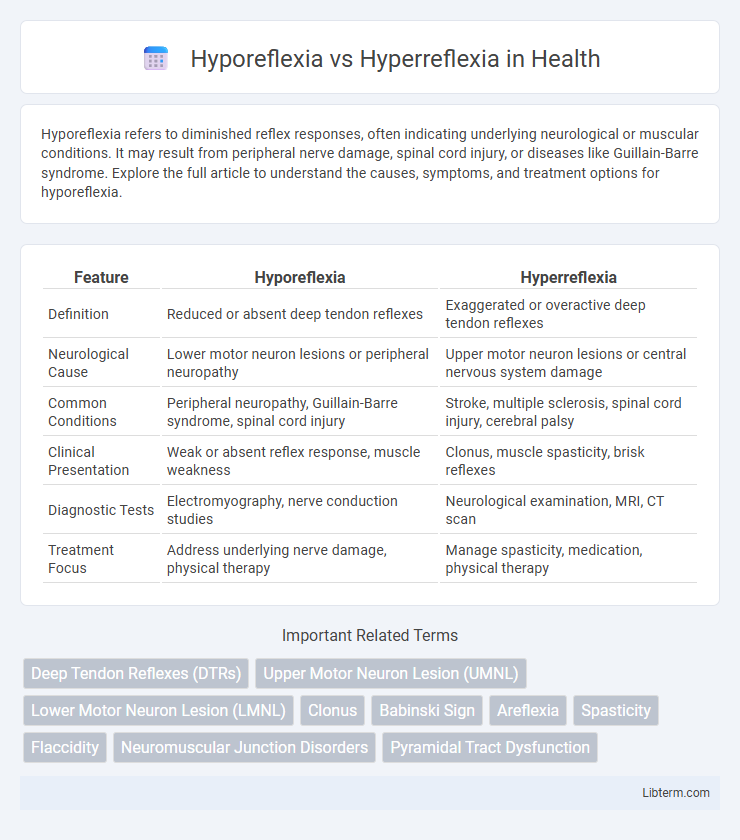Hyporeflexia refers to diminished reflex responses, often indicating underlying neurological or muscular conditions. It may result from peripheral nerve damage, spinal cord injury, or diseases like Guillain-Barre syndrome. Explore the full article to understand the causes, symptoms, and treatment options for hyporeflexia.
Table of Comparison
| Feature | Hyporeflexia | Hyperreflexia |
|---|---|---|
| Definition | Reduced or absent deep tendon reflexes | Exaggerated or overactive deep tendon reflexes |
| Neurological Cause | Lower motor neuron lesions or peripheral neuropathy | Upper motor neuron lesions or central nervous system damage |
| Common Conditions | Peripheral neuropathy, Guillain-Barre syndrome, spinal cord injury | Stroke, multiple sclerosis, spinal cord injury, cerebral palsy |
| Clinical Presentation | Weak or absent reflex response, muscle weakness | Clonus, muscle spasticity, brisk reflexes |
| Diagnostic Tests | Electromyography, nerve conduction studies | Neurological examination, MRI, CT scan |
| Treatment Focus | Address underlying nerve damage, physical therapy | Manage spasticity, medication, physical therapy |
Introduction to Reflexes
Reflexes are automatic, involuntary responses to stimuli critical for maintaining homeostasis and protecting the body. Hyporeflexia, characterized by decreased or absent reflex responses, often indicates peripheral nerve damage or lower motor neuron lesions. Hyperreflexia involves exaggerated reflexes typically associated with upper motor neuron lesions, signaling potential central nervous system dysfunction.
Defining Hyporeflexia
Hyporeflexia is characterized by diminished or absent deep tendon reflexes, often indicating peripheral nerve damage or lower motor neuron lesions. In contrast, hyperreflexia presents as exaggerated reflex responses typically associated with upper motor neuron disorders. Accurate differentiation aids in diagnosing neurological conditions such as peripheral neuropathy in hyporeflexia and spinal cord injury in hyperreflexia.
Understanding Hyperreflexia
Hyperreflexia is characterized by exaggerated reflex responses, often indicating an upper motor neuron lesion or central nervous system disorder such as spinal cord injury, multiple sclerosis, or stroke. It results from disrupted inhibitory signals, causing overactive stretch reflexes and symptoms like muscle spasms or clonus. Differentiating hyperreflexia from hyporeflexia, which involves diminished reflexes due to lower motor neuron damage, helps clinicians localize neurological impairment accurately.
Key Differences Between Hyporeflexia and Hyperreflexia
Hyporeflexia is characterized by diminished or absent deep tendon reflexes, often indicating peripheral nerve damage or lower motor neuron lesions, while hyperreflexia involves exaggerated reflex responses typically signaling upper motor neuron dysfunction. Hyporeflexia can result from conditions such as peripheral neuropathy or spinal cord injury below the reflex arc, whereas hyperreflexia is commonly associated with diseases like multiple sclerosis, stroke, or brain injury affecting the corticospinal tract. Accurate differentiation between hyporeflexia and hyperreflexia is crucial for diagnosing the underlying neurological disorder and guiding appropriate treatment strategies.
Common Causes of Hyporeflexia
Hyporeflexia commonly results from peripheral nervous system disorders such as peripheral neuropathy, Guillain-Barre syndrome, and spinal cord injuries that damage reflex arcs. Conditions like diabetes mellitus and hypothyroidism can also lead to diminished reflex responses by impairing nerve function. In contrast, hyperreflexia typically indicates upper motor neuron lesions, commonly seen in stroke, multiple sclerosis, or spinal cord injury above the reflex arc level.
Common Causes of Hyperreflexia
Hyperreflexia is commonly caused by upper motor neuron lesions resulting from conditions such as stroke, multiple sclerosis, spinal cord injury, or brain tumors, leading to exaggerated reflex responses. Other frequent causes include autoimmune disorders like transverse myelitis and infections affecting the central nervous system, which disrupt normal inhibitory control of reflex arcs. In contrast, hyporeflexia typically arises from lower motor neuron damage, peripheral neuropathies, or muscle disorders, manifesting as diminished or absent reflexes.
Symptoms and Clinical Presentation
Hyporeflexia is characterized by diminished or absent deep tendon reflexes, often accompanied by muscle weakness, reduced muscle tone, and sensory deficits, commonly seen in peripheral neuropathies or lower motor neuron lesions. Hyperreflexia involves exaggerated reflex responses, increased muscle tone (spasticity), and may present with clonus and muscle stiffness, typically indicating upper motor neuron damage or central nervous system disorders. Clinical evaluation differentiates these conditions through reflex testing, muscle strength assessment, and neurological examination to identify underlying pathologies.
Diagnostic Approaches
Neurological examination remains the cornerstone for differentiating hyporeflexia and hyperreflexia, emphasizing deep tendon reflex testing to identify diminished or exaggerated responses. Electromyography (EMG) and nerve conduction studies provide adjunctive data, revealing peripheral nerve damage in hyporeflexia or central nervous system lesions in hyperreflexia. Advanced imaging modalities like MRI are essential to detect structural abnormalities in the corticospinal tract, aiding in the precise diagnosis and differentiation of reflex abnormalities.
Treatment and Management Strategies
Hyporeflexia treatment primarily targets the underlying peripheral nerve or muscle disorder, often involving physical therapy and medications such as corticosteroids or immunosuppressants to reduce inflammation and improve nerve function. Hyperreflexia management centers on controlling the central nervous system cause, frequently using muscle relaxants like baclofen or tizanidine, alongside physical therapy to decrease spasticity and improve mobility. Both conditions require tailored approaches based on specific etiologies, with multidisciplinary rehabilitation playing a crucial role in optimizing patient outcomes.
Prognosis and Long-term Outlook
Hyporeflexia, characterized by diminished or absent reflexes, often indicates peripheral nerve damage with a variable long-term outlook depending on the underlying cause, such as neuropathy or spinal cord injury. Hyperreflexia, marked by exaggerated reflexes, typically suggests central nervous system disorders like upper motor neuron lesions and may signal chronic conditions requiring long-term management. Prognosis for hyporeflexia improves with early intervention in reversible cases, while hyperreflexia prognosis depends on the progression of neurological diseases and the effectiveness of targeted therapies.
Hyporeflexia Infographic

 libterm.com
libterm.com